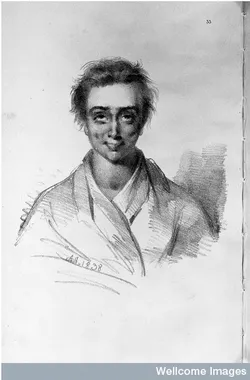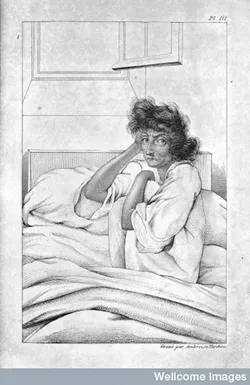Patients' Voices
Jennifer Crane

Photograph of a female psychiatric patient diagnosed with 'erotomania', a delusion in which the affected person believes that another person, often a stranger, high-status or famous person, is in love with them. From Alexander Morrison, The Physiognomy of Mental Diseases (London: Longman, 1843).
Historians of medicine Dale Peterson, Roy Porter and Allan Beveridge have argued that listening to the voices of those labelled 'mad', 'insane' or 'lunatic' helps us to better understand the entangled histories of psychiatry and madness. However, how do we access the opinions, thoughts, and perspectives of long-dead eighteenth- and nineteenth-century patients, who were detained within asylums? Remarkably, a wide variety of patients' voices have been recovered and accessed through the study of pamphlets and books written by released ‘lunatics’ and analysis of letters and diaries written by asylum patients. These works are invaluable for learning about the everyday lives and experiences of these those living within asylums.
Following their release from private asylums, a number of patients wrote pamphlets aiming to document their (perceived) wrongful confinement and to lobby governments and reformers to change asylum conditions. Such accounts were typically provided by highly literate and wealthy or professional individuals. One outstanding example of this genre is provided by Alexander Cruden, an eighteenth-century publisher, proof-reader, and eccentric. Following a ten-week stay in a private asylum in Hoxton, Cruden published The London-Citizen Exceedingly Injured in 1738. In this lengthy pamphlet Cruden describes his incarceration as 'the highest Affront and greatest Provocation'. records a series of injustices he claims to have experienced, including being beaten, and chained to a bed without release for five weeks, and not even being freed to change his clothes or go to the toilet. In one of many dramatic encounters described, he claims a local butcher came to his asylum and:
disfigured Mr C.s face with several blows. . . This cruel Butcher soon after gave him a severe blow, to the great effusion of his blood, with a stick on the head, without the least provocation, and then quickly disappeared, and no body can give any account of him. Mr C. was amaz'd at this uncommon Treatment and asked whether they were all become Madmen?
Cruden hoped that by exposing his case he would improve public knowledge of the abuses enacted within asylums and support his legal battle to gain £10,000 in compensation for his wrongful incarceration. Unfortunately for Cruden, he lost this case in court. Nonetheless, historian Dale Peterson has argued that his pamphlet remains 'a moving account of real abuse of a man accused of madness. . . we must at least conclude that Cruden was treated arbitrarily, unfairly, cruelly'.
Cruden was a public figure who purposefully courted widespread social attention. By contrast, private accounts, intended for personal consumption, for family or for friends, were also written in asylums or following release. Indeed, in a testimony to the therapeutic potential of writing, the creation of letters, diaries, poems and sketches appears to have been quite common. Patients wrote on headed notepaper, postcards, scraps of paper, pages from magazines, and even on toilet paper. An image of the insider experiences of asylum life can be gleaned from these accounts. Whilst every patient’s story is unique, a common theme is discontent with the asylum regime. For example, Miss Edilla D, a 22-year-old gentlewoman admitted to the Royal Edinburgh Asylum, wrote in 1898 that: 'I feel I cannot stand this place a minute longer and soon I shall lose the brains I had. . . I feel I shall go on degenerating in this environment into an animal'.

Insane Patient at a French Asylum. From Ambroise Tardieu, Des maladies mentales considerees sous les rapports medical, hygienique et medico legal (Paris, 1838).
Other patient accounts, however, describe asylums as peaceful and happy environments, with patients describing the new friends they have made inside, or detailing the fine diets and lifestyles they are enjoying. George B., a 49-year-old traveller also detained at the Royal Edinburgh Asylum, wrote to tell his family how 'proud' he felt to live at the asylum and to assure them that his stay 'had done me a world of good. I never felt so comfortable and well in all my life'. Another patient wrote letters proposing marriage to a favourite member of staff.
The variety of patient testimonies reveal varying standards within asylums, particularly the unregulated private asylums. Accounts written by patients also offer a fascinating insight into the daily realities of asylum life, and portray the differing inner experiences of madness. However, these testimonies should not be read as quirky historical artefacts. Rather, as historian Roy Porter argues, these accounts also contain 'astonishing insights into . . .wider questions of normality and abnormality, imagination and judgement, authenticity and personality, power and oppression, and the divided self', issues which remain relevant and contested within the modern world.
Further Reading:
• Dale Peterson, A Mad People's History of Madness (Pittsburgh: University of Pittsburgh Press, 1982).
• Allan Beveridge, 'Life in the Asylum: Patients' Letters from Morningside, 1873-1908', History of Psychiatry, 9 (1998), pp.431-469.
• Roy Porter (ed.) The Faber Book of Madness (London: Faber and Faber, 1991)
• Allan Ingram (ed.) Voices of Madness: Four Pamphlets, 1683-796 (Stroud: Sutton Publishing, 1997).
